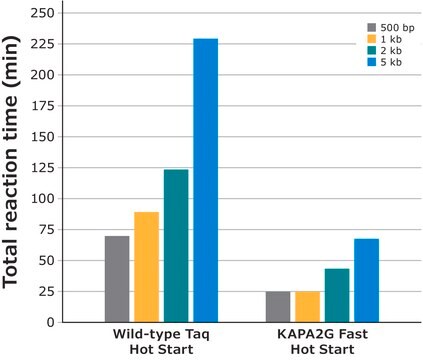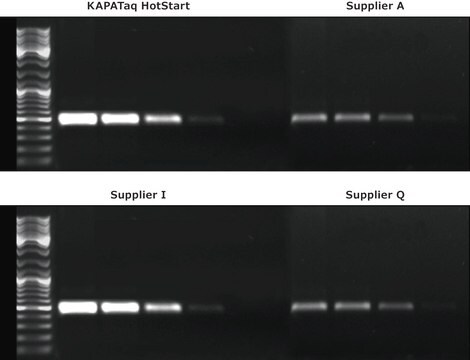Key Documents
2GRHSNTKB
Roche
KAPA2G Robust HotStart PCR Kit
with dNTPs
Synonim(y):
PCR, hotstart PCR
About This Item
Polecane produkty
Poziom jakości
zastosowanie
sufficient for 1000 reactions
sufficient for 200 reactions
sufficient for 500 reactions
okres trwałości
≤12 mo.
Właściwości
Difficult Templates/Specialty Enzymes PCR
dNTPs included
hotstart
opakowanie
pkg of 100 U (KK5532)
pkg of 250 U (KK5516)
pkg of 500 U (KK5518)
producent / nazwa handlowa
Roche
metody
PCR: suitable
moc wejściowa
crude DNA
temp. przechowywania
−20°C
Szukasz podobnych produktów? Odwiedź Przewodnik dotyczący porównywania produktów
Opis ogólny
Zastosowanie
- Amplification of GC- or AT-rich templates
- Templates containing common PCR inhibitors e.g. salts, urea, SDS, or ethanol
- Crude sample PCR e.g. buccal swabs, cultured mammalian, yeast, or bacterial cells
- Colony PCR
- qPCR
- Nested polymerase chain reaction (PCR) amplification
- Amplification of DNA targets in PCR
- DNA amplification using conventional PCR
- Routine PCR
Działania biochem./fizjol.
Cechy i korzyści
- Robust performance across a wide range of GC- and AT-rich templates
- Increased PCR success rates
Improved tolerance to common PCR inhibitors
- Efficient amplification from crude samples
- Higher yield and sensitivity per unit of enzyme
Unrivalled performance in colony PCR
- Higher yields and improved consistency of PCR direct from E. coli and yeast cells
Quick Notes:
- KAPA2G Robust HotStart® PCR Kits with dNTPs contain KAPA2G Robust HotStart DNA Polymerase, engineered for high processivity and inhibitor tolerance.
- Both purified genomic DNA and crude samples (e.g. colony PCR) can be used as template.
- Use 0.5 U of KAPA2G Robust HotStart DNA Polymerase per 25 μL reaction. More challenging PCRs (GCrich,crude sample) may require higher enzyme concentrations.
- Use 15 sec/kb extension time per cycle, and increase to 30-60 sec/kb for difficult amplicons or templates.
- KAPA2G Buffers contain 1.5 mM MgCl2 at 1X.
- Additional MgCl2 may be added using the 25 mM MgCl2 solution provided in the kit.
- KAPA2G Buffer A is optimized for high yield, specificity, and sensitivity.
- KAPA2G Buffer B is recommended for inhibitorcontaminated template samples.
- KAPA2G GC Buffer is recommended for GC-rich PCR (>70% GC).
- KAPA Enhancer 1 can be used with KAPA2G Buffer A or B, particularly for GC-rich assays.
- Reaction products are 3′-dA-tailed and may be cloned into TA cloning vectors.
Jakość
Uwaga dotycząca przygotowania
Inne uwagi
Informacje prawne
Tylko elementy zestawu
- KAPA2G Robust HotStart® DNA Polymerase 5 U/µL
- 5X KAPA2G Buffer A
- 5X KAPA2G Buffer B
- 5X KAPA2G GC Buffer
- 5X KAPA Enhancer 1
- KAPA MgCl2 25 mM
- KAPA dNTP Mix 10 mM each
Hasło ostrzegawcze
Warning
Zwroty wskazujące rodzaj zagrożenia
Zwroty wskazujące środki ostrożności
Klasyfikacja zagrożeń
Acute Tox. 4 Oral - Aquatic Chronic 3 - STOT SE 2
Kod klasy składowania
12 - Non Combustible Liquids
Klasa zagrożenia wodnego (WGK)
WGK 1
Temperatura zapłonu (°F)
does not flash
Temperatura zapłonu (°C)
does not flash
Certyfikaty analizy (CoA)
Poszukaj Certyfikaty analizy (CoA), wpisując numer partii/serii produktów. Numery serii i partii można znaleźć na etykiecie produktu po słowach „seria” lub „partia”.
Masz już ten produkt?
Dokumenty związane z niedawno zakupionymi produktami zostały zamieszczone w Bibliotece dokumentów.
Klienci oglądali również te produkty
Produkty
An overview of directed evolution and the methods for generating proteins with optimized or entirely new functions.
Nasz zespół naukowców ma doświadczenie we wszystkich obszarach badań, w tym w naukach przyrodniczych, materiałoznawstwie, syntezie chemicznej, chromatografii, analityce i wielu innych dziedzinach.
Skontaktuj się z zespołem ds. pomocy technicznej






